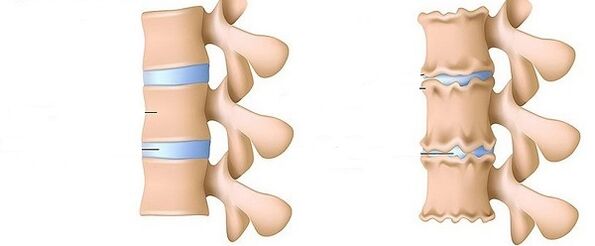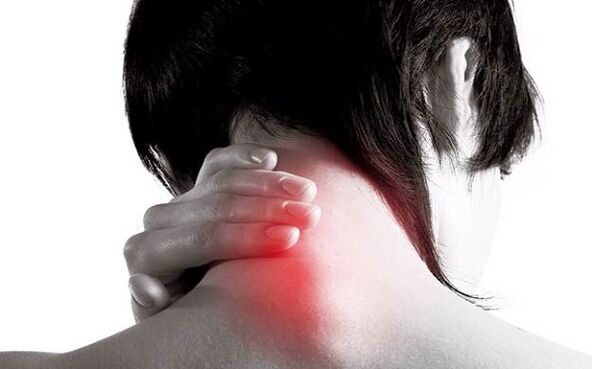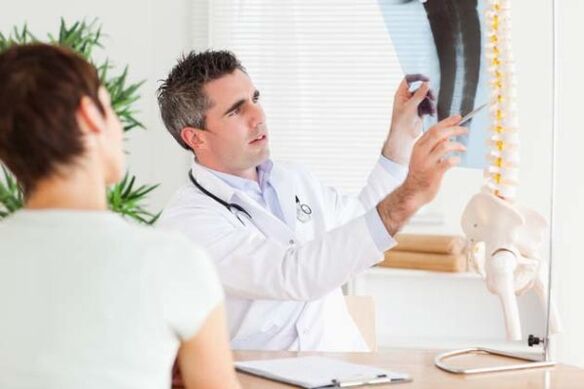Do you often experience pain in your neck and head, and the pain radiates to your arms and shoulders? Maybe you have cervical osteochondrosis, which should be treated as soon as possible? How to diagnose the disease and which doctor to contact? And also how to give first aid for neck osteochondrosis? Read about this and more later in the article.
Characteristics of the disease
For starters, let’s remember what kind of disease it is. So, osteochondrosis of the cervical vertebrae is a disease of the intervertebral disc of the cervical spine, which is the easiest to move. In most cases, lesions occur at the level of the C5 - C7 vertebrae. The symptoms of this disease also depend on which vertebra it affects. More on this later.

Reasons for appearance
To understand how to treat cervical osteochondrosis, you must first understand what causes its appearance. For starters, let’s say that the disease has become more common lately. The age risk zone is from 25 to 40 years. There are many reasons for this disease. The most common are:
- working at a computer, as well as frequent and prolonged driving;
- Not active;
- salt accumulation in the cervical spine;
- impaired metabolism;
- poor nutrition;
- neck injuries;
- rheumatic;
- descent;
- hormonal disorders;
- severe hypothermia, etc.

Symptoms
The disease has a number of symptoms that can manifest themselves together and separately. It all depends on the part of the neck affected. Therefore, to know how to treat cervical spine osteochondrosis, you need to know what is affected and what the consequences are. First, consider the common signs of cervical osteochondrosis.
- It hurts. Pain syndrome is observed in the neck, back of the head, back of the shoulders. Pain can also be given to the hands. This disease is the cause of 30% of all headaches. All due to the fact that with osteochondrosis blood vessels can be pinched. As a result, blood flow to the brain is reduced and severe headaches appear, accompanied by rapid fatigue.
- Crispy. While turning the head and tilting it, a strong feature is felt.
- Numbness. It can occur in the shoulder blade area, accompanied by a strong "lumbago". Also, the neck itself can become numb, while there is an unpleasant tingling sensation in the arms and legs.
- Weakness and dizziness. In addition to all this, fainting often occurs, drowsiness may appear, and general rapid fatigue may be observed.

If the treatment of osteochondrosis of the cervical spine is to be done at home, then you still need to know how to accurately determine the lesion area. Here you only need to know what the symptoms are if one or the nerve roots near the vertebrae are affected. There are 8 such processes in the cervical spine as a whole, and they are designated C1 - C8.
- C1 - with its defeat, disturbance of sensitivity is observed in the occipital region.
- C2 - pain appears in the back of the head and crown.
- C3 - violation is accompanied by severe pain in the area where it occurs. Decreased neck sensitivity. The taste sensitivity of the tongue is disturbed. Speech problems may occur.
- C4 - pain in the liver and heart. There is also numbness and pain in the shoulder and between the shoulder blades.
- C5 - pain and decreased sensitivity in the upper shoulder.
- C6 - areas including the neck and shoulders are very sore. The pain spreads to the shoulders and radiates to the arms, reaching the thumbs of the hands.
- C7 - the symptoms are similar to C6, but the pain spreads to the back of the shoulder and to the rest of the arm, affecting the remaining fingers, except the little finger.
- C8 - similar to C7. In addition, numbness and pain have reached the little finger.
Types
Are you wondering if it is possible to cure cervical spine osteochondrosis at home? Then you need to know the extent of the disease you are experiencing. After all, only the first stage of treatment can be done at home. In total, 3 degrees of the disease can be distinguished based on its progression.
- The first - the process is almost invisible and you do not even begin to think about how to deal with cervical osteochondrosis. But at this stage it is possible to prevent the development of the disease. Symptoms include periodic numbness in the neck and the area between the shoulder blades during prolonged sitting. Pain is rare, but may accompany numbness, and increased fatigue.
- The second type is the development of the disease. The intervertebral disc has shrunk and deformed, but can still be repaired. With movement of the neck, itching and pain are felt, while the movement is limited. Needs immediate medical attention.
- The third type is the advanced stage of the disease. Here the integrity of the disk is compromised. Pain in the neck, head, shoulders is almost constant. Painful sensations are given to the hands, up to the fingers. The emergence of diseases such as hernias is possible. With further deformities and improper fusion of the vertebrae, the fight against the disease can only be continued with surgical methods.
Where to get help?
So you have some signs of the disease, and you decide not to sit still, but seek expert help. The question is being made, "What doctor treats cervical osteochondrosis? " Well, it all depends on the stage of the disease you are experiencing. So, wound treatment at level 1 can be handled by a therapeutic gymnast or masseur. This also includes alternative medicine, i. e. directions such as osteopathy.
Stage 2 osteochondrosis of the cervical spine already requires observation by a doctor at the polyclinic. Here in the manual, a physiotherapist or reflex therapist can deal with the pain. Also, there is no need to consult a neurologist. Grade 3 cervical osteochondrosis requires more professional medical treatment. Here, a neurologist should initially deal with the disease, as there are several nerve endings in the cervical spine. In further cases, the surgeon treats osteochondrosis of the cervical spine along with a neuropathologist.

Diagnostics
Before treating osteochondrosis of the neck, you need to undergo an examination. The treating doctor will feel your neck, perform some manipulations, and question you. Be sure to set an X-ray of the cervical ridge. In addition, general blood tests will be prescribed. For a more detailed understanding of the disease, they may be sent for an MRI or CT scan.
How is treatment carried out?
For starters, let’s answer the question, "Is it possible to cure cervical osteochondrosis? " Yes, it is possible, but it is possible to overcome the disease only at an early stage. So how to beat cervical osteochondrosis? There are different treatments for this, which are described below.
Medicine
Drugs are the most effective method of treating cervical osteochondrosis in grades 2 and 3. Complex treatment is carried out here. Therefore, some medication should relieve the pain that is tormenting you. Other drugs fight inflammation. There are still others - relieving swelling, a fourth drug restores blood circulation and supplies nutrients to the diseased area. They can all be in tablet form, and in the form of injections and injections. With osteochondrosis of the cervical spine, the ointment will not be effective.

All treatments of cervical osteochondrosis in women and men are divided into 3 stages.
- First, medications should quickly relieve pain, relieve swelling and have anti-inflammatory effects.
- In the second stage, each drug should produce a regenerative healing effect.
- The third stage is recovery. These include vitamins, restorative gymnastics and massage.
Since you are tormented by osteochondrosis and you decide to go to the hospital, do not self -medicate and follow all your doctor’s instructions.
Physiotherapy
Physiotherapy can answer how to cure cervical spine osteochondrosis. The most commonly used methods are:
- magnetotherapy;
- electrotherapy;
- laser treatment;
- UFO;
- other balneotherapy.
Surgical intervention
Sometimes, only a surgeon can answer how to get rid of cervical osteochondrosis. Surgery is scheduled after consultation with a neurologist. Here the surgeon should try as much as possible so that the osteochondrosis that beats you subsides. After surgery, be prepared for a long recovery
ethnoscience
And what will folk medicine say to all this? There are adequate methods and methods for the treatment of such diseases. However, remember that you are acting at your own risk and peril, therefore only you are responsible for the consequences. So, how to deal with osteochondrosis using folk remedies.
- The first method is a compress for cervical osteochondrosis from Indian onions. To do this, you need to take the leaves of the plant and rub the sore area with it, and then use the residue as an overnight compress. The healing effect should be observed the next day.
- Another compress for the night is prepared from cottage cheese sprinkled with vinegar. It is done several nights in a row until the appearance of the treated effect.
- Carrot leaves are used in a similar way. We take the freshly picked leaves of the plant, rinse with boiling water and apply it to the sore spot overnight, having previously wrapped it in something warm.
- How to cure cervical osteochondrosis with a shovel? And here everything is quite simple. The fact is that we do not need a whole shovel, but only a part of it is needed, which is called a handle of more than one meter. To remove the miracle cure, you have to take it with both hands and wrap it around your neck. Next, with up and down movements, we massage the sore area. The procedure should be performed several times a day, at least a week.

Contraindications to treatment
Sometimes the difficult question arises, "What can you do with cervical osteochondrosis, and what not? " It has been stated that not all medical procedures have only a therapeutic effect. Sometimes it can harm the patient. Therefore, it should only be treated with the recommendation of the attending physician. So, this includes the following procedures used to treat osteochondrosis:
- acupuncture;
- rehabilitative gymnastics or exercise therapy;
- massage.
Doing acupuncture for osteochondrosis is contraindicated if you are 75 years of age or older, as well as for pregnant women. The remaining points of contraindication for this procedure are the same as for massage. This includes:
- Blood diseases.
- Any kind of bleeding.
- Increased mental excitement.
- Hard to breath.
- Digestive system problems.
Exercise therapy or complex physical therapy, with diseases such as osteochondrosis, also has contraindications. The most common are unhealed injuries, severe bruising, and hematomas. Contraindications here include:
- sudden increase in disease;
- weak heart;
- manifestations of tachycardia or arrhythmias;
- severe forms of diabetes;
- bleeding tendency;
- infectious wounds;
- there are diseases associated with the vestibular apparatus;
- have vision problems;
- neurological symptoms that cause loss of coordination.
How to give first aid?
If osteochondrosis makes you shocked at home, then first aid is as follows:
- Take the painkillers you have at your normal dose.
- Contact a doctor at home, as you may need more radical methods and other medications.
- Try not to make sudden movements with your head or body.
- Remove the cover from the bed and lie down with a small pillow under your head. If the mattress is soft enough, lay it on a bench or floor.
- Try to relax and think of something good so that the pain reliever can work faster. If the doctor is late, do not lie in one position for long periods of time.
















